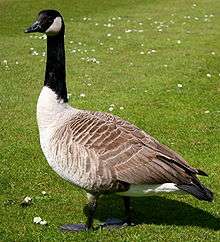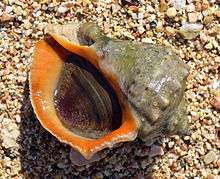List of invasive species in Europe
Also see Invasive species in the British Isles
This is a list of invasive species in Europe. A species is regarded as invasive if it has become introduced to a location, area, or region where it did not previously occur naturally (i.e., is not a native species) and becomes capable of establishing a breeding population in the new location. An invasive species will be one that thrives in its new environment and negatively influences the ecology and biodiversity of that ecosystem.
The term invasive species refers to a subset of those species defined as introduced species. If a species has been introduced but remains local, and is not problematic to agriculture or to the local biodiversity, then it cannot be considered to be invasive, and does not belong on this list.
Plants
- Ailanthus altissima (Tree of heaven)[1]
- Amorpha fruticosa (Desert false indigo)[2]
- Ambrosia artemisiifolia (Amrosia artemisifolia)[3]
- Carpobrotus edulis (Hottentot fig)[4]
- Caulerpa racemosa (Grape caulerpa)[5]
- Caulerpa taxifolia, Mediterranean clone[6]
- Clematis vitalba (Old man's beard)[7]
- Crassula helmsii (Australian swamp stonecrop)[8]
- Elodea canadensis (Canadian pondweed)[9]
- Fallopia japonica (Japanese knotweed)[10]
- Gleditsia triacanthos (Honey locust)
- Heracleum mantegazzianum (Giant hogweed)[11]
- Hydrocotyle ranunculoides (Floating pennywort)[12]
- Impatiens glandulifera (Himalayan balsam)[13]
- Myriophyllum aquaticum (Parrot feather)[14]
- Rhododendron ponticum(pontic rhododendron)[15]
- Robinia pseudoacacia (Black locust)[16]
Animals
Cnidarians
- Diadumene lineata (Orange-lined anemone)
Arthropods
Crustaceans
- Balanus improvisus (Bay barnacle)[17]
- Dikerogammarus villosus (Killer shrimp)[18]
- Eriocheir sinensis (Chinese mitten crab)[19]
- Homarus americanus (American lobster)[20]
- Orconectes limosus[21]
- Orconectes virilis (Virile crayfish)[22]
- Pacifastacus leniusculus (Signal crayfish)[23]
- Paralithodes camtschaticus (Red king crab)[24]
- Procambarus clarkii (Louisiana crawfish)[25]
- Procambarus fallax f. virginalis (Marmorkrebs)[26]
Insects
- Harmonia axyridis (Asian lady beetle)[27]
- Leptinotarsa decemlineata (Colorado beetle)[28]
Chordates
Ascidians
- Styela clava (Stalked sea squirt)[29]
Amphibians
Birds

- Alopochen aegyptiacus (Egyptian goose)[30]
- Anser cygnoides (Swan goose)
- Anser indicus (Bar-headed goose)
- Branta canadensis (Canada goose)
- Corvus splendens (House crow)
- Myiopsitta monachus (Monk parakeet)
- Oxyura jamaicensis (Ruddy duck)[31]
- Psittacula krameri (Rose-ringed parakeet)[32]
Fish
- Lepomis gibbosus (Pumpkinseed sunfish)[33]
- Oncorhynchus mykiss (Rainbow trout)[33]
- Ameiurus melas (Black bullhead (catfish))[33]
- Micropterus salmoides (Largemouth Bass)[33]
Mammals
- Eutamias sibiricus (Siberian chipmunk)
- Muntiacus reevesi (Reeves's muntjac)
- Mustela vison (American mink)
- Myocastor coypus (Coypu, nutria)
- Nyctereutes procyonoides (Raccoon dog)
- Ondatra zibethicus (Muskrat)
- Rattus norvegicus (Brown rat)
- Rattus rattus (Black rat)
- Sciurus carolinensis (Grey squirrel)
- Procyon lotor (Common raccoon)
Reptiles
- Trachemys scripta elegans (Red-eared slider)
Molluscs
Marine


- Crassostrea gigas (Pacific oyster)
- Crepidula fornicata (Common slipper shell)
- Ensis directus (American jack-knife clam)
- Rapana Venosa (Veined rapa whelk)[34]
Freshwater
- Corbicula fluminea (Freshwater bivalve mollusk)[35][36]
- Dreissena polymorpha (Zebra mussel)
- Dreissena rostriformis bugensis (Quagga mussel)[37]
- Ferrissia fragilis (Freshwater limpet)[38]
- Melanoides tuberculata (Red-rimmed melania)
- Potamopyrgus antipodarum (New Zealand mud snail)
- Sinanodonta woodiana (Chinese pond mussel)[36]
Platyhelminthes
- Arthurdendyus triangulatus (New Zealand flatworm)
- Australoplana sanguinea (Australian flatworm)
- Bipalium kewense (hammerhead flatworm)[39][40]
- Platydemus manokwari (New Guinea flatworm)[41]
Pathogens
- Ophiostoma ulmi (Dutch elm disease)
References
- ↑ Ailanthus altissima distribution in Europe. ISSG Global Invasive Species Database. Retrieved on 2009-03-03.
- ↑ EPPO List of invasive alien plants. European and Mediterranean Plant Protection Organization. Retrieved on 2009-04-10.
- ↑ Ambrosia artemisiifolia. Gyűjtő Zsolt SAPIENTIA Hungarian University of Transilvania Faculty of Sciences and Arts, Cluj-Napoca. Retrieved on 2010-11-30.
- ↑ Alien range of Carpobrotus edulis. ISSG Global Invasive Species Database. Retrieved on 2009-03-03.
- ↑ Durand, C., et al. 2002. Molecular data suggest a hybrid origin for the invasive Caulerpa racemosa (Caulerpales, Chlorophyta) in the Mediterranean Sea. Journal of Evolutionary Biology 15:122-133.
- ↑ Alien range of Caulerpa taxifolia. ISSG Global Invasive Species Database. Retrieved on 2009-03-03.
- ↑ Invasive Species Compendium. "Clematis vitalba". Retrieved October 2011. Check date values in:
|access-date=(help) - ↑ Most Unwanted: New Zealand pigmyweed. Invasive Species Ireland. Retrieved on 2009-04-10.
- ↑ Barrat-Segretain, M. 2001. [Invasive species in the Rhône river floodplain (France): replacement of Elodea canadensis michaux by E. nuttallii St. John in two former river channels]. (Abstract). Archiv für Hydrobiologie 152(2):237-251.
- ↑ Fallopia japonica distribution in Europe. ISSG Global Invasive Species Database. Retrieved on 2009-03-03.
- ↑ Heracleum mantegazzianum distribution in Europe. ISSG Global Invasive Species Database. Retrieved on 2009-03-03.
- ↑ Maguire, C.M., Cosgrove, P.J. and Kelly, J. 2008. Floating Pennywort (Hydrocotyle ranunculoides) Management Plan. Invasive Species Ireland. Retrieved on 2009-04-10.
- ↑ Impatiens glandulifera alien range. Global Invasive Species Database. Retrieved on 2009-04-10.
- ↑ Myriophyllum aquaticum distribution in the United Kingdom. ISSG Global Invasive Species Database. Retrieved on 2009-03-03.
- ↑ Invasive Alien Species in Northern Ireland: Rhododendron ponticum. National Museums Northern Ireland. Retrieved on 2009-04-10.
- ↑ Robinia pseudoacacia distribution in Europe. ISSG Global Invasive Species Database. Retrieved on 2009-03-03.
- ↑ "Bay barnacle (Balanus improvisus)" (PDF). Främmande arter i svenska hav. Retrieved April 18, 2010.
- ↑ Danielle M. Crosnier & Daniel P. Molloy (October 2006). "Killer Shrimp - Dikerogammarus villosus" (PDF). Aquatic Nuisance Species Research Program. United States Army Corps of Engineers. Retrieved September 9, 2010.
- ↑ Eriocheir sinensis alien range. Global Invasive Species Database. Retrieved on 2009-04-10.
- ↑ Invasive Alien Species Fact Sheet: Homarus americanus. North European and Baltic Network on Invasive Alien Species. Retrieved on 2009-04-10.
- ↑ Holdich, D. and Black, J. 2007. The spiny-cheek crayfish, Orconectes limosus (Rafinesque, 1817) (Crustacea: Decapoda: Cambaridae), digs into the UK. Aquatic Invasions 2(1):1–16.
- ↑ The virile crayfish, Orconectes virilis (Hagen, 1870) (Crustacea: Decapoda: Cambaridae), identified in the UK. Ahern, Daniel, et al. 2008. Aquatic Invasions 3(1):102-104. Retrieved on 2008-12-03.
- ↑ Pacifastacus leniusculus alien range. Global Invasive Species Database. Retrieved on 2009-04-10.
- ↑ Invasive Alien Species Fact Sheet: Paralithodes camtschaticus. North European and Baltic Network on Invasive Alien Species. Retrieved on 2009-04-10.
- ↑ Procambarus clarkii alien range. Global Invasive Species Database. Retrieved on 2009-04-10.
- ↑ Christoph Chucholl & Michael Pfeiffer (2010). "First evidence for an established Marmorkrebs (Decapoda, Astacida, Cambaridae) population in Southwestern Germany, in syntopic occurrence with Orconectes limosus (Rafinesque, 1817)" (PDF). Aquatic Invasions. 5 (4): In press. doi:10.3391/ai.2010.5.4.10.
- ↑ Harmonia axyridis alien range. Global Invasive Species Database. Retrieved on 2009-04-10.
- ↑ Invasive Alien Species in Northern Ireland: Leptinotarsa decemlineata. National Museums Northern Ireland. Retrieved on 2009-04-10.
- ↑ Styela clava alien range. Global Invasive Species Database. Retrieved on 2009-04-10.
- ↑ Article 8(h) - Alien Species. Third National Report of Belgium to the Convention on Biological Diversity. Retrieved on 2009-04-10.
- ↑ Control and Eradication of the North American Ruddy Duck in Europe. Henderson, Iain and Robertson, Pete. Managing Vertebrate Invasive Species: Proceedings of an International Symposium. Fort Collins, Colorado, August 7–9, 2007. Retrieved on 2008-12-07.
- ↑ Menchetti, Mattia; Mori, Emiliano; Angelici, Francesco Maria (2016). Effects of the recent world invasion by ring-necked parakeets Psittacula krameri. Springer International Publishin. pp. 253–266. doi:10.1007/978-3-319-22246-2_12. ISBN 978-3-319-22246-2.
- 1 2 3 4 Leppakoski, Erkki. Invasive aquatic species of Europe: distribution, impacts, and management. Kluwer Academic Publishers. 1998. The Netherlands. 156-162.
- ↑ 100 of the worst invasive species in Europe
- ↑ Morais, P.; et al. (2009). "The Asian clam Corbicula fluminea (Müller, 1774) in the Guadiana River Basin (southwestern Iberian Peninsula): Setting the record straight" (PDF). Aquatic Invasions. REABIC. 4 (4): 681–684. doi:10.3391/ai.2009.4.4.14.
- 1 2 Popa, O.; Popa, L. O. (2006). "Sinanodonta woodiana (Lea, 1834), Corbicula fluminea (O. F. Müller, 1774), Dreissena bugensis (Andrusov, 1897) (Mollusca: Bivalvia): Alien invasive species in Romanian fauna" (PDF). Travaux du Muséum National d'Histoire Naturelle "Grigore Antipa". 49: 7–12.
- ↑ Katharina C. M. Heiler, Sascha Brandt, Christian Albrecht, Torsten Hauffe, Thomas Wilke: A new approach for dating introduction events of the quagga mussel (Dreissena rostriformis bugensis). In: Biological Invasions. Online First.
- ↑ Distribution of the alien freshwater snail Ferrissia fragilis (Tryon, 1863) (Gastropoda: Planorbidae) in the Czech Republic. Beran, Lubos. 2007. Aquatic Invasions 2(1):45-54. Retrieved on 2008-12-03.
- ↑ Álvarez-Presas, M.; Mateos, E.; Tudó, À.; Jones, H.; Riutort, M. (2014). "Diversity of introduced terrestrial flatworms in the Iberian Peninsula: A cautionary tale". PeerJ. 2: e430. doi:10.7717/peerj.430. PMC 4060057
 . PMID 24949245.
. PMID 24949245. - ↑ Mazza, Giuseppe; Menchetti, Mattia; Sluys, Ronald; Solà, Eduard; Riutort, Marta; Tricarico, Elena; Justine, Jean-Lou; Cavigioli, Luca; Mori, Emiliano (2016). "First report of the land planarian Diversibipalium multilineatum (Makino & Shirasawa, 1983) (Platyhelminthes, Tricladida, Continenticola) in Europe". Zootaxa. 4067 (5): 577. doi:10.11646/zootaxa.4067.5.4. ISSN 1175-5334.

- ↑
- Justine, Jean-Lou; Winsor, Leigh; Gey, Delphine; Gros, Pierre; Thévenot, Jessica (2014). "The invasive New Guinea flatworm Platydemus manokwari in France, the first record for Europe: time for action is now.". PeerJ. 2: e297. doi:10.7717/peerj.297. PMC 3961122
 . PMID 24688873.
. PMID 24688873. 
- Justine, Jean-Lou; Winsor, Leigh; Gey, Delphine; Gros, Pierre; Thévenot, Jessica (2014). "The invasive New Guinea flatworm Platydemus manokwari in France, the first record for Europe: time for action is now.". PeerJ. 2: e297. doi:10.7717/peerj.297. PMC 3961122